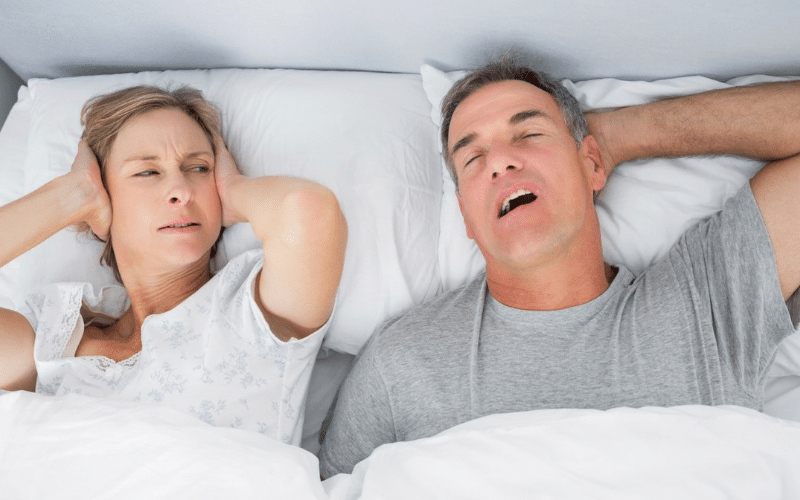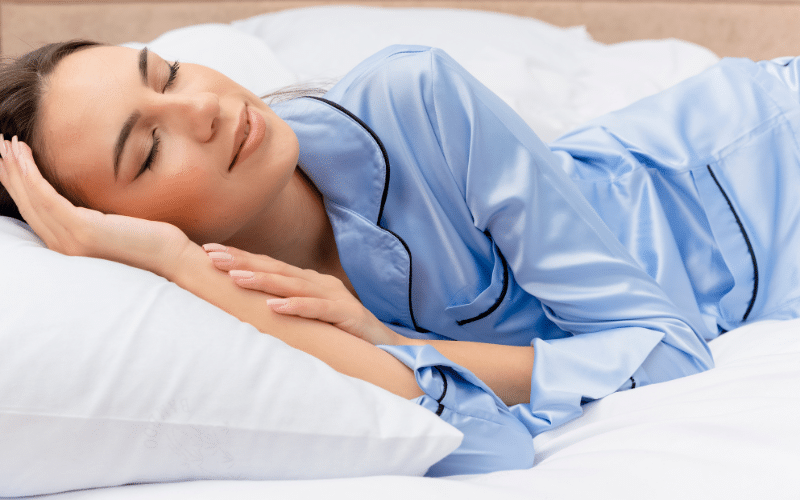ONLINE SCHEDULING AND VIRTUAL CONSULTS AVAILABLE

Sleep Apnea Awareness: Signs, Symptoms, and Treatment Options

Sleep apnea is a common yet often undiagnosed sleep disorder. It disrupts the normal breathing patterns during sleep, leading to pauses in breathing or shallow breaths. These interruptions can occur multiple times throughout the night, resulting in fragmented sleep and a myriad of health complications. Many individuals may dismiss occasional snoring or daytime fatigue as harmless. However, they could be signs of underlying sleep apnea, warranting attention and intervention. Understanding the signs, symptoms, and available treatment options is crucial for promoting better sleep and overall well-being.
In this comprehensive guide, we will take a detailed look into the condition, shedding light on its various facets, from the subtle signs that may go unnoticed to the potential health risks associated with untreated sleep apnea. By exploring the causes, diagnosis methods, and treatment modalities, we aim to equip readers with the knowledge needed to recognize sleep apnea’s impact and take proactive steps towards better sleep hygiene and improved quality of life.
Signs and Symptoms of Sleep Apnea
Recognizing the signs and symptoms of sleep apnea is essential for early detection and intervention to mitigate its effects on overall health. While the severity of symptoms may vary among individuals, common indicators include persistent snoring, gasping for air during sleep, and daytime fatigue. Other noticeable signs may include morning headaches, irritability, and difficulty concentrating. Beyond affecting sleep quality, untreated sleep apnea can lead to serious health complications such as hypertension, heart disease, and stroke.
- Persistent snoring, often loud and disruptive
- Episodes of gasping or choking during sleep
- Daytime fatigue, even after a full night’s rest
- Morning headaches and dry mouth
- Irritability, mood swings, and difficulty concentrating
These symptoms not only impact daily functioning but also increase the risk of accidents and reduced quality of life. Furthermore, untreated sleep apnea can exacerbate existing health conditions and contribute to the development of new ones. Therefore, recognizing the signs and seeking medical evaluation is crucial for effective management and prevention of associated health risks.
Risk Factors and Causes
Sleep apnea can affect individuals of all ages and backgrounds, but certain factors increase the likelihood of developing this sleep disorder. These risk factors can be categorized into modifiable and non-modifiable factors. Factors that increase the risk of developing sleep apnea:
- Obesity: Excess weight, especially around the neck, can obstruct the airway during sleep.
- Age: The condition becomes more common as individuals age, with middle-aged and older adults at higher risk.
- Gender: Men are more likely to develop the condition than women, although the risk in women increases after menopause.
- Family history: Having family members with this condition may increase an individual’s risk due to genetic factors.
- Smoking: Tobacco use can increase inflammation and fluid retention in the airway, contributing to it as well
- Alcohol and sedative use: Consuming alcohol or sedatives before bedtime can relax the throat muscles, leading to airway collapse.
Underlying causes and mechanisms
- Obstructive sleep apnea (OSA): Occurs when the muscles in the throat relax excessively during sleep, causing partial or complete airway obstruction.
- Central sleep apnea (CSA): Results from the brain’s failure to send proper signals to the muscles that control breathing.
- Mixed sleep apnea: Combination of obstructive and central sleep apnea.
Understanding these risk factors and underlying causes is essential for early identification and management of sleep apnea, ultimately improving overall health and well-being.
Diagnosis of Sleep Apnea
Diagnosing the conditon involves a comprehensive evaluation of an individual’s medical history, symptoms, and physical examination, followed by specialized sleep studies and diagnostic tests.
Medical history and physical examination:
Symptom assessment: Healthcare providers will inquire about symptoms such as loud snoring, witnessed pauses in breathing during sleep, daytime fatigue, and morning headaches.
Risk factor evaluation: Factors such as obesity, smoking, alcohol consumption, and family history of sleep apnea are assessed.
Physical examination: Examination of the mouth, throat, and neck may reveal physical characteristics associated with sleep apnea, such as enlarged tonsils or a recessed jaw.
Sleep studies and diagnostic tests
Polysomnography (PSG): Considered the gold standard for diagnosing the condition, PSG involves monitoring various physiological parameters during sleep, including airflow, oxygen levels, and brain activity.
Home sleep apnea tests (HSAT): These portable devices allow individuals to undergo sleep studies in the comfort of their own homes. They typically monitor breathing patterns, oxygen saturation, and heart rate.
Other diagnostic tests: In some cases, additional tests such as nocturnal oximetry, multiple sleep latency tests (MSLT), or maintenance of wakefulness tests (MWT) may be performed to evaluate daytime sleepiness and rule out other sleep disorders.
These diagnostic procedures help healthcare providers determine the presence, severity, and type of sleep apnea. It can guide appropriate treatment strategies for individuals experiencing this sleep disorder.
Treatment Options
Treating the conditon typically involves a combination of lifestyle changes, medical interventions, and, in some cases, surgical procedures. Here are some common treatment options:
Continuous Positive Airway Pressure (CPAP) therapy
- CPAP is a highly effective treatment for obstructive sleep apnea (OSA), the most common type of sleep apnea.
- It involves wearing a mask connected to a machine that delivers a steady stream of air pressure to keep the airway open during sleep.
- CPAP therapy helps prevent episodes of breathing cessation and reduces symptoms such as snoring and daytime fatigue.
- While CPAP is considered the gold standard treatment for sleep apnea, some individuals may find it challenging to tolerate due to mask discomfort or claustrophobia.
Oral appliances and mandibular advancement devices
- These devices are designed to reposition the lower jaw and tongue to prevent airway obstruction during sleep.
- Oral appliances are custom-made by dentists and are suitable for individuals with mild to moderate sleep apnea or those who cannot tolerate CPAP therapy.
- Mandibular advancement devices are worn over the teeth and are adjustable to gradually move the jaw forward, helping to keep the airway open.
Surgical interventions for severe cases
- Surgery may be recommended for individuals with severe sleep apnea who do not respond to other treatments or have anatomical abnormalities contributing to airway obstruction.
- Surgical procedures may involve removing excess tissue from the throat, repositioning the jaw, or implanting devices to support the airway.
- Surgical interventions are typically considered a last resort and are carefully evaluated based on individual circumstances and medical history.
These treatment options aim to alleviate symptoms, improve sleep quality, and reduce the long-term health risks associated with untreated sleep apnea. It’s essential for individuals with sleep apnea to work closely with healthcare providers to determine the most suitable treatment approach for their specific needs and preferences.
Lifestyle Changes and Management Strategies
In addition to medical interventions, making lifestyle changes and adopting management strategies can play a crucial role in managing sleep apnea. Here are some lifestyle adjustments that can help:
Weight management and dietary adjustments: Maintaining a healthy weight and following a balanced diet can reduce the severity of sleep apnea symptoms. Losing excess weight can decrease the amount of fatty tissue around the neck that may contribute to airway obstruction during sleep.
Positional therapy and sleeping habits: Sleeping on the side instead of the back can help prevent the tongue and soft tissues from blocking the airway. Using pillows or positional devices to encourage side sleeping can be beneficial.
Avoidance of alcohol and sedatives before bedtime: Alcohol and sedatives relax the muscles in the throat, increasing the risk of airway collapse and worsening the symptoms. It’s best to avoid these substances in the hours leading up to bedtime.
Understanding the signs, symptoms, and treatment options for the condition is crucial for maintaining overall health and well-being. By recognizing the common indicators and risk factors associated with this sleep disorder, individuals can seek timely medical evaluation and intervention. From lifestyle modifications to medical therapies like CPAP and oral appliances, a comprehensive approach to treatment can significantly improve sleep quality and reduce the risks of complications linked to untreated sleep apnea.
Ultimately, prioritizing sleep health and seeking professional guidance can empower individuals to manage the condition and its associated challenges effectively. With the right diagnosis and personalized treatment plan, individuals can take proactive steps toward achieving restful sleep and enjoying improved quality of life.





